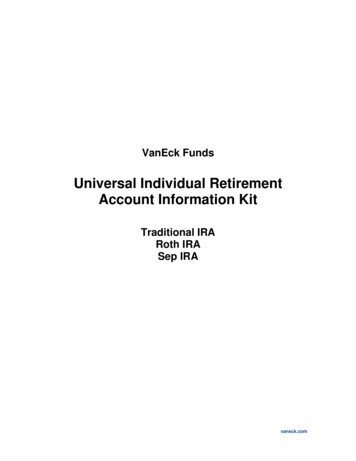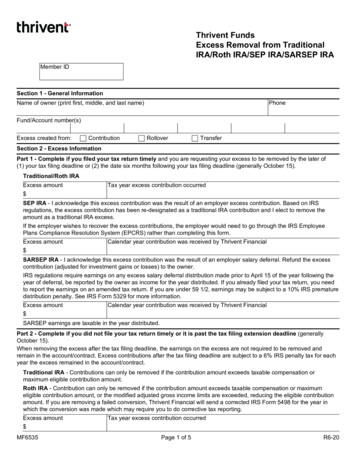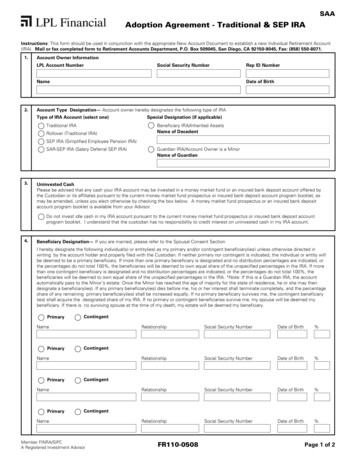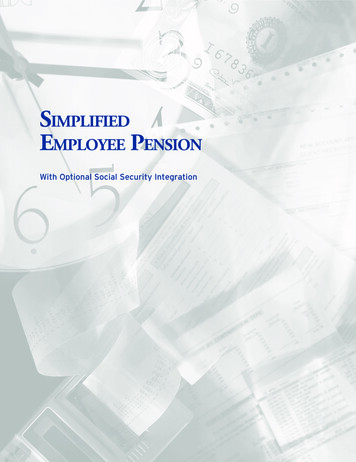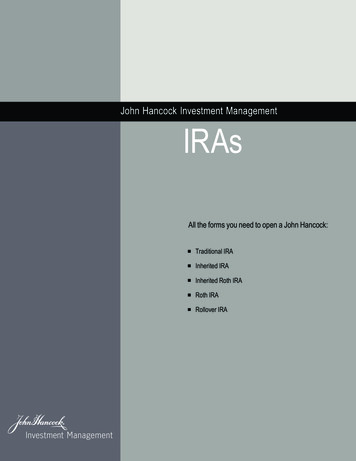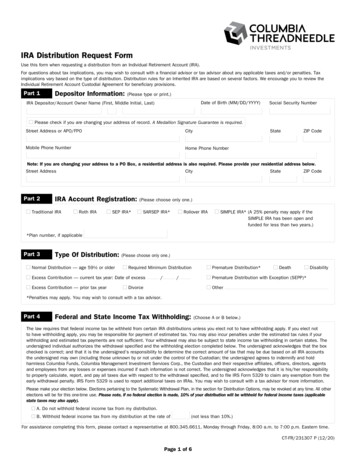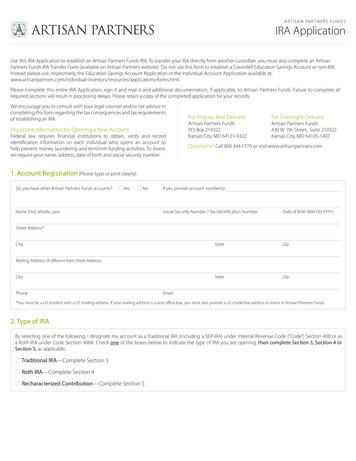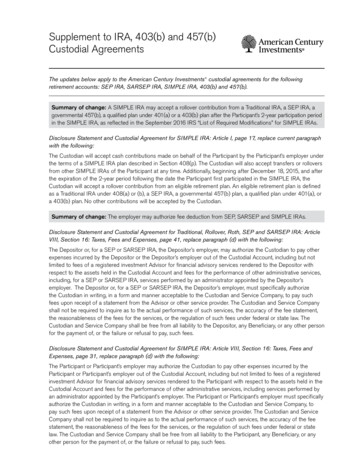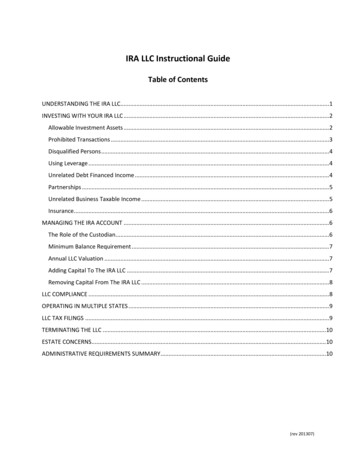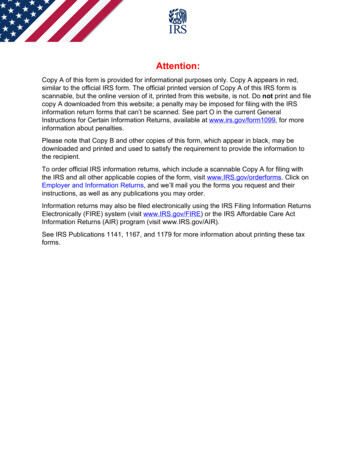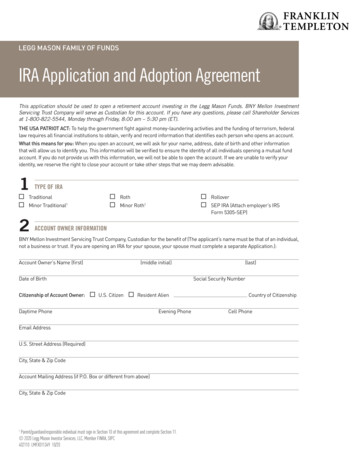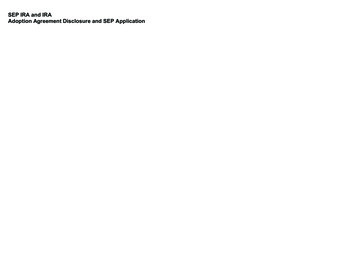
Transcription
SEP IRA and IRAAdoption Agreement Disclosure and SEP Application
TO ESTABLISH A HILLTOP SECURITIESINC. SEP IRA AND IRAADOPTION AGREEMENT DISCLOSURE AND SEP APPLICATION Complete and sign all portions of the SEP IRA Adoption Agreement and account application. When completingthe beneficiary information please make sure to include social security numbers. Submit the completed SEP IRA Adoption Agreement to your Account Executive. Enclose a check made payable to Hilltop Securities Inc. for the initial SEP IRA contribution, if applicable.Make sure all checks include the tax year information for the contribution and the account number. If you are transferring an existing SEP IRA to Hilltop Securities Inc. (Hilltop Securities), complete and sign anAccount Transfer Form. When submitting the form to your Account Executive, include a copy of the most recentaccount statement. If you are rolling funds from a qualified plan to a SEP, complete and sign a Rollover Certification Form. Contact your Account Executive for any other forms that may be required to establish your SEP IRA or with anyother questions or concerns that you may have. Unrelated Business Income Tax: If the Depositor directs investments of the account in any investment whichresults in unrelated business taxable income, it shall be the responsibility of the Depositor to so advise theCustodian and to provide the Custodian with all the information necessary to prepare and file any required returnsor reports for the account. As the Custodian may deem necessary, and at the Depositor’s expense, the Custodianmay request a taxpayer identification number for the account, file any returns, reports, and applications forextension, and pay any taxes or estimated taxes owed with respect to the account. The Custodian may retainsuitable accountants, attorneys, or other agents to assist it in performing such responsibilities.THIS CUSTODIAL FEE INFORMATION MAY ONLY BE USEDWITH HILLTOP SECURITIES IRA ACCOUNTSCUSTODIAL FEES FOR INDIVIDUAL RETIREMENT ACCOUNTS Initial Set Up or Acceptance Fee Annual Maintenance FeeSee your Customer Information Brochure Spousal Annual Maintenance FeeSee your Customer Information Brochure Transfer FeeSee your Customer Information Brochure Termination FeeNo Charge 50.00*Hilltop Securities Inc. reserves the right to change fees upon notification to the account holder.Revised (10/05/2015)
PROTOTYPE SIMPLIFIED EMPLOYEE PENSIONPLAN AGREEMENTARTICLE IAdoption and Purpose of Plan1.01 Adoption of Plan: By completing and signing the Adoption Agreement, the Employer adopts the Sponsoring Organization's Prototype SimplifiedEmployee Pension Plan. This Agreement must be used with an Internal Revenue Service Model traditional IRA (Form 5305 or Form 5305-A) or an IRSapproved Master or Prototype traditional IRA.1.02 Purpose: The purpose of this Plan is to provide benefits for the individuals who are eligible to participate hereunder. It is intended that this Plan be for theexclusive benefit of the Employer's Employees, and that the Plan qualify under Section 408(k) of the Code.1.03 Limitation: If the Employer amends this plan other than by making an election permitted in the Adoption Agreement, the Employer will no longerparticipate in the Sponsoring Organization's Prototype Simplified Employee Pension Plan, the Employer will be considered to have an individuallydesigned SEP Plan, and the Employer may no longer rely on the IRS opinion letter received in connection with this Prototype Simplified EmployeePension Plan.ARTICLE IIEligibility and Participation2.01 Eligible Employees: All Employees of the Employer shall be eligible to participate in this Plan except for Excludible Employees as defined under Section2.02 of this Plan.2.02 Excludible Employees: If the Employer elects in the Adoption Agreement, the following Employees shall be excluded from eligibility:(a)Employees included in a unit of employees covered by a collective bargaining agreement between employee representatives and the Employer,provided that there is evidence that retirement benefits were the subject of good faith bargaining between such parties, unless such agreementprovides that some or all of such covered employees are to be covered by this Plan. For purposes of this paragraph, the term "employeerepresentatives" does not include any organization more than half of whose members are employees who are owners, officers, or executives of theEmployer.(b) Non-resident alien employees who receive no earned income from the Employer which constitutes income from sources within the United States.(c) Employees who have not met the age and service requirements specified in the Adoption Agreement.(d) Employees who did not earn at least 450 (as adjusted for cost of living increases in accordance with Code §408(k)(8)) of Compensation from theEmployer during the Plan Year.2.03 Participation:(a) Each Employee who meets the eligibility requirements as specified in the Adoption Agreement shall, as a condition for further employment, becomea Participant under this SEP Plan.(b) Each eligible Employee shall establish an IRA in order to receive Employer contributions under this Agreement, and any Employer contributionsshall be made directly to such IRA plan. Unless otherwise elected in the Adoption Agreement, such IRA shall be established with the Trustee.(c) If a Participant fails to timely establish or to maintain an IRA in which SEP contributions may be made on such Participant's behalf, the Employermay execute any necessary documents to establish an IRA with the Trustee into which such contributions shall be made on behalf of theParticipant.(d) If an Employer maintained a SEP Plan and desires to change to a Plan Year other than a calendar year, an Employee who has any service duringthe short Plan Year must be given credit for that service in three of the last five years. Such an Employee must also receive a contribution for theshort Plan Year if such Employee would have been entitled to a contribution for the calendar year in which the short Plan year begins if there hadbeen no change.ARTICLE IIIWritten Allocation Formula3.01 Amount of Contribution: The Employer agrees to contribute on behalf of each eligible Employee for the Plan Year an amount determined under thewritten allocation formula specified in the Adoption Agreement.3.02 Uniform Relationship to Compensation:(a) All Employer contributions to this Plan shall bear a uniform relationship to the total Compensation (not to exceed 200,000, or such higher amountas may be permitted under law) of each Participant.(b) If the Employer elects the Flat Dollar Contribution allocation in the Adoption Agreement, such contributions shall be deemed to bear a uniformrelationship to the total compensation of each Participant.3.03 Limitation on Employer Contributions: The maximum employer contribution which may be made for any one Plan Year with respect to any Participantand allocated to each Participant's IRA is the lesser of 25% of such Participant's Compensation for the Plan Year or 40,000 as adjusted under Code§ 415(d). For purposes of the 25% limitation described in the preceding sentence, a participant's compensation does not include any elective deferraldescribed in Code § 402(g)(3) or any amount that is contributed by the employer at the election of the employee and that is not includible in the grossincome of the employee under Code §§ 125, 132(f)(4) or 457.3.04 Permitted Disparity for Certain Contributions:(a) Definite Integrated Contribution Formula: If elected in the Adoption Agreement, the Employer will contribute an amount equal to the BaseContribution Percentage selected in the Adoption Agreement (but not less than 3%) of each Participant's Compensation (as defined in Section 4.04of the Plan) for the Plan Year, up to the Integration Level plus an amount equal to the Excess Contribution Percentage selected in the AdoptionAgreement (but not less than 3% and not to exceed the Base Contribution Percentage by more than the lesser of: (i) the Base ContributionPercentage, or (ii) the Maximum Disparity Rate) of such Participant's Excess Compensation.(b) Discretionary Integrated Contribution Formula: If elected in the Adoption Agreement, Employer contributions for the Plan Year will be allocated toParticipants' accounts as follows:STEP 1: Contributions will be allocated to each Participant's account in the ratio that each Participant's total Compensation bears to the totalCompensation of all Participants, at a rate not in excess of 3% of each Participant's Compensation.STEP 2: Any contributions remaining after the allocation in Step One will be allocated to each Participant's account in the ratio that eachParticipant's Excess Compensation bears to the Excess Compensation of all Participants, at a rate not in excess of 3% of such ExcessCompensation. For purposes of this Step Two, in the case of any Participant who has exceeded the Cumulative Permitted Disparity Limit describedbelow, such Participant's total Compensation for the calendar year will be taken into account.STEP 3: Any contributions remaining after the allocation in Step Two will be allocated to each Participant's account in the ratio that the sum of eachCopyright 1991-2011, PenServ Plan Services, Inc.Control 06002 IRS.doc (7-11) (7-11)1
(c)(d)(e)Participant's total Compensation and Excess Compensation bears to the sum of all Participants' total Compensation and Excess Compensation, ata rate not in excess of the Maximum Disparity Rate. For purposes of this Step Three, in the case of any Participant who has exceeded theCumulative Permitted Disparity Limit described below, 2 times such Participant's total Compensation for the calendar year will be taken intoaccount.STEP 4: Any remaining Employer contributions will be allocated to each Participant's account in the ratio that each Participant's total Compensationbears to the total Compensation of all Participants.For purposes of the allocations made pursuant to this Section 3.04, in no event can the amount allocated to each Participant's IRA exceed thelesser of 25% of the first 200,000 (or such higher amount, as may be permitted under law) of compensation or 40, 000, as adjusted under Code§415(d). For purposes of the 25% limitation described in the preceding sentence, a Participant's compensation does not include any electivedeferral described in Code §402(g)(3) or any amount that is contributed by the employer at the election of the employee and that is not includible inthe gross income of the employee under Code §§125, 132(f)(4) or 457.Annual Overall Permitted Disparity Limit: Notwithstanding the preceding paragraphs, for any calendar year this SEP benefits any Participant whobenefits under another SEP or qualified plan described in Code Section 401(a) maintained by the Employer that provides for Permitted Disparity (orimputes disparity), Employer contributions will be allocated to each Participant's IRA in the ratio that the participant's total compensation for thecalendar year bears to all Participants' total Compensation for that year.Cumulative Permitted Disparity Limit: Effective for calendar years beginning on or after January1, 1995, the Cumulative Permitted Disparity Limit fora Participant is 35 total Cumulative Permitted Disparity Years. Total Cumulative Permitted Disparity Years means the number of years credited tothe Participant for allocation or accrual purposes under this SEP or any other SEP or any qualified plan described in Code Section 401(a) (whetheror not terminated) ever maintained by the Employer. For purposes of determining the Participant's Cumulative Permitted Disparity Limit, all yearsending in the same Calendar Year are treated as the same year. If the Participant has not benefited under a defined benefit or target benefit plan forany year beginning on or after January 1, 1994, the Participant has no Cumulative Permitted Disparity Limit.ARTICLE IVGlossary of Plan Terms4.01 Adoption Agreement: The document executed by the Employer through which it adopts the Plan and agrees to be bound by all terms and conditions ofthe Plan.4.02 Base Contribution Percentage: The percentage of Compensation contributed under the Plan (but in no event less than 3%) with respect to that portionof each Participant's Compensation not in excess of the Integration Level.4.03 Code: The Internal Revenue Code of 1986 and the regulations issued thereunder as heretofore or hereafter amended. Reference to a section of theCode shall include that section and any comparable section or sections of future legislation that amends, supplements or supersedes that section.4.04 Compensation; 415 Safe Harbor Compensation: Compensation is defined as wages, salaries, and fees for professional services and other amountsreceived (without regard to whether or not an amount is paid in cash) for personal services actually rendered in the course of employment with theemployer maintaining the plan to the extent that the amounts are includible in gross income (including but not limited to, commissions paid salesmen,compensation for services on the basis of a percentage of profits, commissions on insurance premiums, tips, bonuses, fringe benefits, andreimbursements, or other expense allowances under a nonaccountable plan (as described in Section 1.61-2(c) IRC), and excluding the following:(a) Employer contributions to a plan of deferred compensation which are not includible in the employee's gross income for the taxable year in whichcontributed, or employer contributions under a simplified employee pension plan, or any distributions from a plan of deferred compensation;(b) Amounts realized from the exercise of a nonqualified stock option, or when restricted stock (or property) held by the employee either becomes freelytransferable or is no longer subject to a substantial risk of forfeiture;(c) Amounts realized from the sale, exchange or other disposition of stock acquired under a qualified stock option; and(d) Other amounts which received special tax benefits, such as premiums for group-term life insurance (but only to the extent the premiums are notincludible in the gross income of the employee).4.054.064.074.084.094.104.11For any Self-Employed individual covered under the plan, Compensation will mean Earned Income.Compensation shall include only that compensation which is actually paid or made available to the Participant during the year.Except where specifically stated otherwise in this plan, a Participant's Compensation shall include any elective deferral described in Code§ 402(g)(3) or any amount that is contributed by the employer at the election of the employee and that is not includible in the gross income of theemployee under Code §§ 125, 132(f)(4) or 457.The annual compensation of each participant taken into account under the SEP for any year shall not exceed 200,000, as adjusted for increases in thecost of living in accordance with Code § 401(a)(17)(B). If the SEP determines compensation for a period of time that contains fewer than 12 calendarmonths, then the annual compensation limit is an amount equal to the annual compensation limit for the calendar year in which the compensation periodbegins multiplied by a fraction, the numerator of which is the number of full months in the short compensation period, and the denominator of which is 12.Earned Income: The net earnings from self-employment in the trade or business with respect to which the Plan is established, for which personalservices of the individual are a material income-producing factor. Net earnings will be determined without regard to items not included in gross incomeand the deductions allocable to such items. Net earnings are reduced by contributions by the Employer to qualified plans or to a SEP plan to the extentdeductible under Section 404 of the Code. Net earnings shall be determined with regard to the deduction allowed to the Employer by Section 164(f) of theCode.Employee: An individual, including a Self-Employed, employed by the Employer, who performs services with respect to the trade or business of theEmployer. Also any employee of any other employer required to be aggregated under Section 414(b), (c) or (m) of the Code; any leased employee withinthe meaning of Section 414(n) of the Code shall be considered an Employee; and all Employees required to be aggregated under section 414(o) of theCode.Employer: The sole proprietorship, partnership, corporation or other entity identified as such in the Adoption Agreement.Excess Compensation: A Participant's Compensation in excess of the Integration Level.Excess Contribution Percentage: The percentage of Compensation contributed under the Plan with respect to each Participant's ExcessCompensation.Integration Level: The taxable wage base, or such lesser amount elected by the Employer in the Adoption Agreement. The taxable wage base is themaximum amount of earnings which may be considered wages for a year under section 3121(a)(1) of the Code in effect as of the beginning of the PlanYear.Maximum Disparity Rate:(a) If the Definite Integrated Contribution Formula is selected by the Employer under Section 3.04(a) above, the Maximum Disparity Rate is equal to thelesser of:(i) 5.7%; or(ii) the applicable percentage determined in accordance with Table I below.Copyright 1991-2011, PenServ Plan Services, Inc.Control 06002 IRS.doc (7-11) (7-11)2
Table IIf the Integration Levelis more than 0X* of Taxable Wage Base80% of Taxable Wage BaseEqual to the Taxable Wage BaseBut not more thanX*80% of Taxable Wage BaseY**N/Athe applicable percentage is:5.7%4.3%5.4%5.7%*X the greater of 10,000 or 20% of the Taxable Wage Base.**Y any amount more than 80% of the Taxable Wage Base but less than 100% of the Taxable Wage Base.(b)If the Discretionary Integrated Contribution Formula is selected by the Employer under Section 3.04(b) above, the Maximum Disparity Rate is equalto the lesser of:(i) 2.7%; or(ii) the applicable percentage determined in accordance with Table II below:Table IIIf the Integration Levelis more than 0X* of Taxable Wage Base80% of Taxable Wage BaseEqual to the Taxable Wage BaseBut not more thanX*80% of Taxable Wage BaseY**N/Athe applicable percentage is:2.7%1.3%2.4%2.7%*X the greater of 10,000 or 20% of the Taxable Wage Base**Y any amount more than 80% of the Taxable Wage Base but less than 100% of the Taxable Wage Base.(c)4.124.134.144.154.164.17In no event can the amount allocated to each participant's IRA exceed the lesser of 25% of the participant's compensation or 40,000, as adjustedunder Code § 415(d). For purposes of the 25% limitation described in the preceding sentence, a participant's compensation does not include anyelective deferral described in Code § 402(g)(3) or any amount that is contributed by the employer at the election of the employee and that is notincludible in the gross income of the employee under Code §§ 125, 132(f)(4) or 457.Participant: Any Employee who has met the eligibility requirements of this Plan and who is eligible to receive an Employer contribution.Plan: The Sponsoring Organization's Prototype Simplified Employee Pension Plan consisting of this plan document and the Adoption Agreement ascompleted and signed by the Employer.Plan Year: The 12-consecutive month period specified by the Employer in the Adoption Agreement.Self-Employed: An individual who has Earned Income for a Plan Year from the trade or business for which the Plan is established. A Self-Employed alsoincludes an individual who would have had Earned Income but for the fact that the trade or business had no net profits for the Plan Year.Sponsoring Organization: The entity specified in the Adoption Agreement.Trustee: The financial institution or other organization specified in the Adoption Agreement which qualifies under section 408(a) of the Code and isserving as Trustee or Custodian of the IRA plan to which an Employer contribution is made.Copyright 1991-2011, PenServ Plan Services, Inc.Control 06002 IRS.doc (7-11) (7-11)3
PROTOTYPE SEP DISCLOSURE STATEMENTINFORMATION FOR THE EMPLOYEEThe information provided below explains what a Simplified Employee Pension (SEP) plan is, how contributions are made, and how to treat your employer'scontributions for tax purposes. Please read the questions and answer carefully. For more specific information, see the Prototype SEP Plan document andAdoption Agreement executed by your Employer. Also, see IRS Publication 560.QUESTIONS & ANSWERSQ1 What is a Simplified Employee Pension, or SEP?A1A SEP is a written arrangement (a plan) that allows an employer to make contributions toward your retirement. Contributions are made to a traditionalindividual retirement account/annuity (IRA).Your employer will provide you with a copy of the agreement containing participation rules and a description of how employer contributions may be madeto your IRA.All amounts contributed to your IRA by your employer belong to you even after you stop working for that employer.Q2 Must my employer contribute to my IRA under the SEP?A2No. An employer is not required to make SEP contributions. If a contribution is made, it must be allocated to all the eligible employees according to theSEP agreement. The Prototype SEP Plan specifies that the contribution for each eligible employee will be the same percentage of compensation(excluding compensation higher than a specified dollar limit that is subject to cost-of-living adjustments) for all employees. The compensation limit is:200620072008200920102011 220,000 225,000 230,000 245,000 245,000 245,000Q3 How much may my employer contribute to my SEP IRA in any year?A3Your employer will determine the amount to be contributed to your traditional IRA each year. However, the amount for any year is limited to the smaller of 40,000 or 25% of your compensation for that year. The 40,000 maximum SEP contribution limit is subject to cost-of-living adjustments. Compensationdoes not include any amount that is contributed by your employer to your traditional IRA under the SEP. Your employer is not required to makecontributions every year or to maintain a particular level of contributions. See Question 5. The SEP contribution limit is:200620072008200920102011Q4 How do I treat my employer's SEP contributions for my taxes?A4 44,000 45,000 46,000 49,000 49,000 49,000Employer contributions to your SEP IRA are excluded from your income unless there are contributions in excess of the applicable limit. See Question 3.Employer contributions within these limits will not be included on your Form W-2.Q5 May I also contribute to my IRA if I am a participant in a SEP?A5Yes. You may contribute the smaller of the annual regular IRA contribution limit or 100% or your compensation to an IRA. However, the amount you candeduct may be reduced or eliminated because, as a participant in a SEP, you are covered by an employer retirement plan. See Question 11.Q6 Are there any restrictions on the IRA I select to have my SEP contributions deposited?A6Contributions must be made to either a Model traditional IRA executed on an IRS form or a master or prototype traditional IRA for which the IRS hasissued a favorable opinion letter.Q7 What if I do not want to participate in a SEP?A7If your employer does not require you to participate in a SEP as a condition of employment, and you elect not to participate, all other employees of youremployer may be prohibited from participating. If one or more eligible employees do not participate and the employer fails to establish a SEP IRA for theremaining eligible employees, it could cause adverse tax consequences for the participating employees.Q8 Can I move funds from my SEP IRA to another traditional IRA?A8Yes. You can withdraw or receive funds from your SEP IRA if within 60 days of receipt, you place those funds in the same or another traditional IRA orSEP IRA. This is called a "rollover" and can be done without penalty only once in any 1-year period. However, there are no restrictions on the number oftimes you may make "transfers" if you arrange to have these funds transferred between the trustees or the custodians so that you never have possessionof the funds.Copyright 1991-2011, PenServ Plan Services, Inc.Control 06002 IRS.doc (7-11) (7-11)4
Q9 Can I move my funds from my SEP IRA to another employer plan?A9Yes. Beginning with distributions received in 2002, you may also roll over to a qualified plan (under section 401(a)), a qualified annuity, a 403(b) taxsheltered annuity or custodial agreement, or an eligible 457(b) plan of a state or local government.Q10 Are there any restrictions to rollovers from my IRA?A10 Yes. You may not roll over to an employer plan (See Question 9) any basis in your IRA. Basis includes nondeductible IRA contributions, after-tax moniesthat were rolled into the IRA from an employer plan, or repayments of qualified reservist distributions.Q11 What happens if I withdraw my employer's contribution from my IRA?A11 You may withdraw your employer's contribution at any time, but any amount withdrawn is includible in your income unless rolled over. Also, if withdrawalsoccur before you reach age 59½, you may be subject to an additional tax on early withdrawal.Q12 Are there any restrictions in withdrawing the funds in my SEP IRA?A12 You may withdraw the funds in your IRA at any time. However, a withdrawal from a certificate of deposit prior to maturity may result in a forfeiture ofprincipal or interest. These penalties, as well as any fees which may be charged, are set forth in the IRA disclosure statement you received when youopened your account and/or any specific disclosure accompanying your certificate of deposit (including rules of class) or other investment.An IRA with another institution may have different terms concerning transfers, withdrawals, rates of return, etc. It is possible that the terms offered atanother institution may be more advantageous.Q13 May I participate in a SEP even though I am covered by another plan?A13 An employer may adopt this Prototype SEP in conjunction with any qualified plan, including a defined benefit plan. Also, if your employer maintained inthe past a defined benefit plan, which is now terminated the employer may adopt this Prototype SEP.Q14 What happens if too much is contributed to my SEP IRA in one year?A14 Contributions exceeding the yearly limitations may be withdrawn without penalty by the due date (plus extensions) for filing your tax return (normally April15), but are includible in your gross income. Excess contributions left in your SEP IRA account after that time may have adverse tax consequences.Withdrawals of those contributions may be taxed as premature withdrawals.Q15 Is my employer required to provide me with information about SEP IRAs and the SEP agreement?A15 Yes. Your employer must provide you with a copy of the executed SEP Plan agreement with Adoption Agreement and a yearly statement showing anySEP contributions to your traditional IRA.Q16 Is the financial institution where my traditional IRA is established required to provide me with information?A16 Yes. It must provide you with a disclosure statement that contains the following information in plain, nontechnical language.(1)(2)(3)(4)(5)(6)The law that relates to your traditional IRA.The tax consequences of various options concerning your traditional IRA.Participation eligibility rules, and rules on the deductibility of retirement savings.Situations and procedures for revoking your traditional IRA, including the name, address, and telephone number of the person designated toreceive notice of revocation. This information must be clearly displayed at the beginning of the disclosure statement.A discussion of the penalties that may be assessed because of prohibited activities concerning your traditional IRA.Financial disclosure that provides the following information:(a)(b)(c)Projects value growth rates of your traditional IRA under various contribution and retirement schedules, or describes the method ofdetermining annual earnings and charges that may be assessed.Describes whether, and for when, the growth projections are guaranteed, or a statement of the earnings rate and the terms on which theprojections are based.States the sales commission for each year expressed as a percentage of 1,000.In addition, the financial institution must provide you with a financial statement each year. You may want to keep these statements to evaluate yourtraditional IRA's investment performance.See IRS Publication 590, Individual Retirement Arrangements (IRAs), available at most IRS offices, for a more complete explanation of the IRA disclosurerequirements.In addition to this disclosure statement, the financial institution is required to provide you with a financial statement each year. It may be necessary to retainand refer to statements for more than one year in order to evaluate the investment performance of the traditional IRA and in order that you will know how toreport traditional IRA distributions for tax purposes.Copyright 1991-2011, PenServ Plan Services, Inc.Control 06002 IRS.doc (7-11) (7-11)5
5305-AForm(Rev. March 2002)Department of the TreasuryInternal Revenue ServiceTraditional Individual Retirement Custodial Account(Under Section 408(a) of the Internal Revenue Code)Article I1.01 Except in the case of a rollover contribution described in section 402(c), 403(a)(4), 403(b)(8), 408(d)(3), or 457(e)(16), an employer contribution to a simplifiedemployee pension plan as described in section 408(k) or a recharacterized contribution described in section 408A(d)(6), the Custodian will accept only cashcontributions up to 3,000 per year for tax years 2002 through 2004. That contribution limit is increased to 4,000 for tax years 2005 through 2007, and 5,000 for 2008 and thereafter. For individuals who have reached the age of 50 before the close of the tax year, the contribution
PLAN AGREEMENT ARTICLE I Adoption and Purpose of Plan 1.01 Adoption of Plan: By completing and signing the Adoption Agreement, the Employer adopts the Sponsoring Organization's Prototype Simplified Employee Pension Plan. This Agreement must be used with an Inte rnal Revenue Service Model tradi tional IRA (Form 5305 or Form 5305-A) or an IRS
